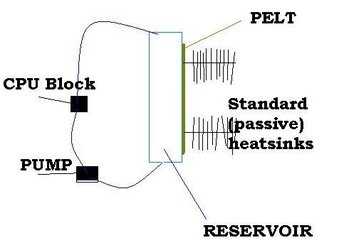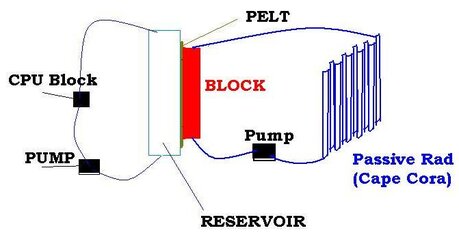i'm saying that using the passive radiators (loop) would be more efficient & more compact than cooling the pelts hot sides with "ordinary" Air heatsinks.
There are a few other concerns also, see below
As for geo, i've got a design which involves a lot less digging, drilling & bending

i'll (re-)post it someday
A few issues... math is inevitable

No matter how "conductive", we are actually talking about termal barriers.
die > tim (or solder) -> ihs -> tim (eg pk1) -> copper base of waterblock -> water
water -> res wall (copper?) -> cold block -> pelt -> hot block -> tim -> HeatSink base -> heatpipe -> alu fins -> air
Ideally one should work out each layer to find the maximum thermal transfer possible - this is where material properties & C/W values & joules, etc come in

Unfortunately, some of these values are either unknown or unclear or too variable.
Acutally, all of these values or the calculations to achieve these values can be probably found on the net somewhere, but since there is no big "X marks the spot" & i dont feel like doing all that work for you ... 
The only thing we know for sure is that the stuff used between the die & ihs on a ivy bridge is "less than optimal"
Therefore, i'm going to commit a few sins & risk a spanking by Conumdrum
The first sin is that i'm going to ignore the whole die -> tim -> ihs -> tim -> block limits and consider it one whole item and ASSUME 100% efficiency
The second sin is that i'm going to forfait C/W, joules , ... and just gonna use WATTS.
Doing so simplifies the whole issue and allows some abstraction , while it increases the error and the (considerable) risk to my own life

Anywas, because of simplex model, we can assume that 1 WATT produced at the die goes straight into the Water.
So, 100 Watts produced goes into the water and means 100 watts has to be taken out by the pelt(s)
Meaning that the pelt(s) have to take out the 100 watts in the same timeframe/cycle at the "cost" of using 150 watts of power. Meaning that 100+150=250 watts will need to be dissipated into the air by the passive heatsink(s)
Here comes the issue:
Assume you've got quite a "beefy" waterloop which contains 1/4 gallon water
Assume you've got a good 1 - 1.5 GPM flow, which is not unreasonable
At 1 GPM flow, it suggests that ALL the water in your loop runs by the CPU & through the res 4 times per minute
So, in order to dissipate 100 watts produced / min, the water has to pick up 25 Watts at each pass AND the pelt(s) need to be able to pick up 25 Watts at each pass. The passive HS need to dump 250 watts/min into the air.
All this to stay close at ambient
So, it all seems to work out on paper (when roughly sketched), given that the thermal capacity of Water is 4.1 kJ/kg °C0 , and 1kg water = 1 liter which is close enough to 1/4 gallon (what a coincidence) to marginalise our ... margin of error... then the water itself does not seems to be the limiting factor.
A few questions remain
Is the waterblock *really* good enough to transfer the equivalent of 100 Watts to the water/min? (given limited contact surface -> not sure)
Are the pelts able to suck the equivalent of 100 Watts/min out of the water? (Stick on enough of them to have enough surface contact -> doable)
Is water able to pick-up & dump the equivalent of 100 watts / min?
Is air capable of picking up the equivalent of 250 watts /min from your passive heatsinks? (i suspect you need to bolt on at least 4-6 evo's to keep it under control)
Will it all be "portable"? (whats the weight of one evo?

What Will be the cost of powering the pelts

And since i am sure that besides my sins, i made some terrible logical errors, will i be able to suffer the consequences with dignity?





